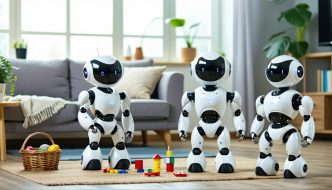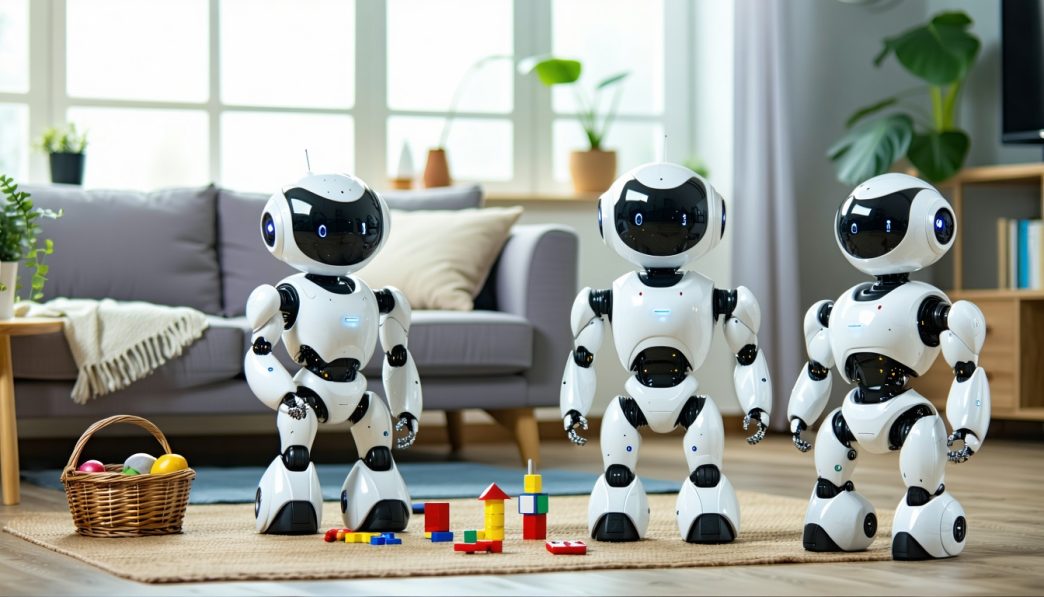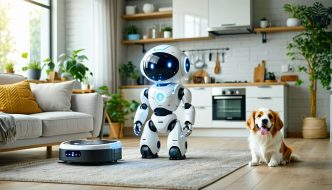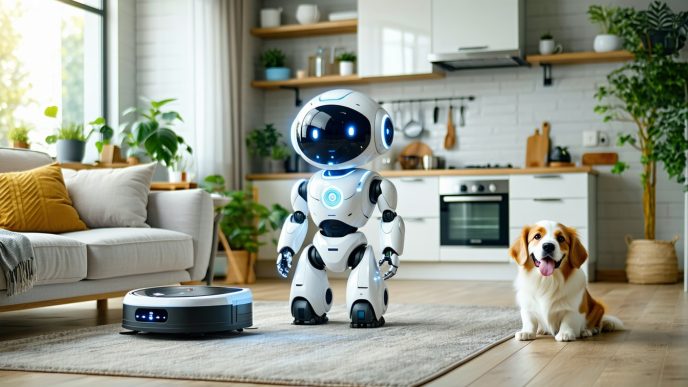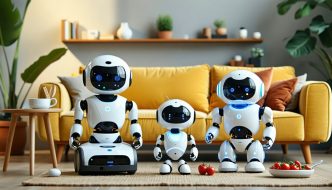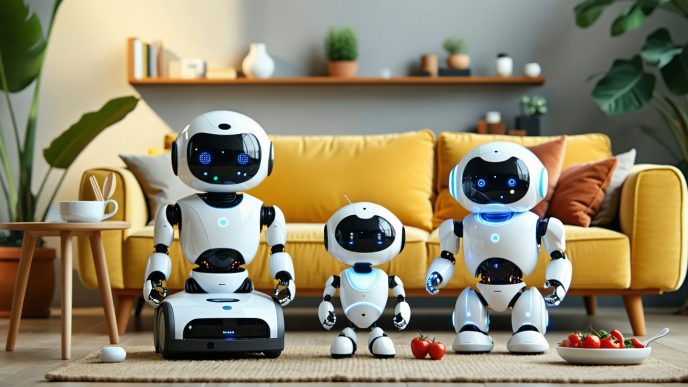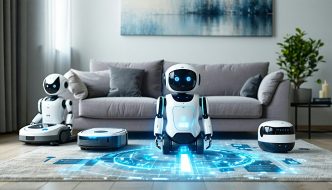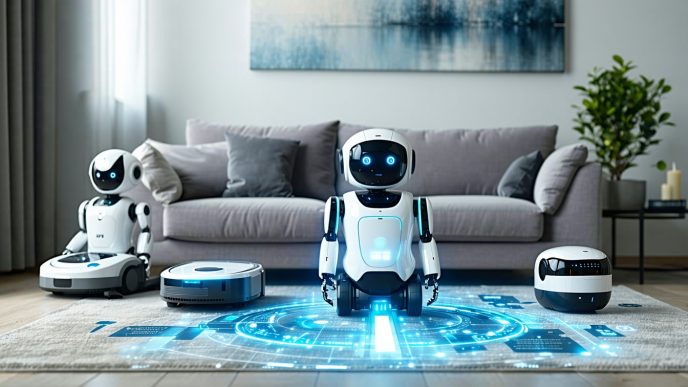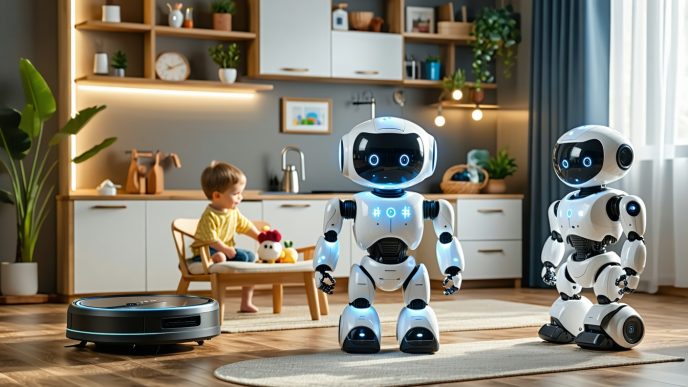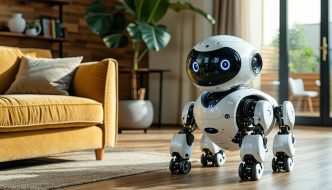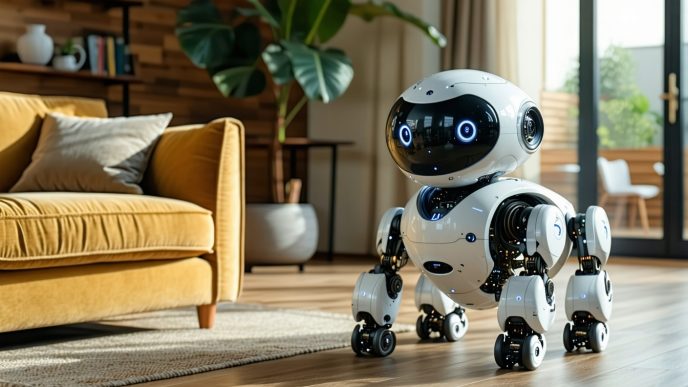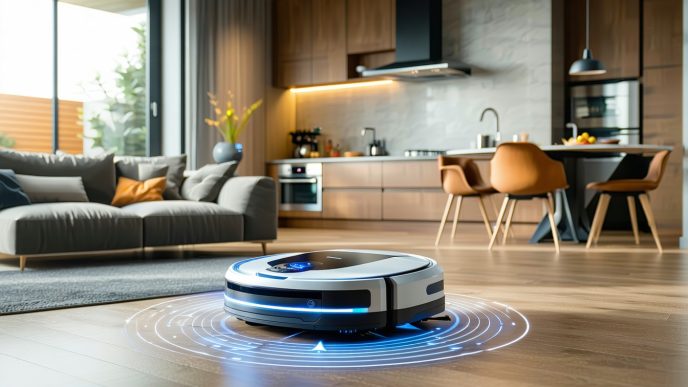Robots in Small Spaces
Benefits of Humanoid Robots in Small Apartments
Humanoid robots offer various advantages for residents in small apartments and compact homes. These robots provide functionality that utilizes limited floor space effectively, enhancing daily living in several ways:
-
Space Efficiency: Humanoid robots can perform multiple tasks without taking up much space. Their compact design allows them to navigate tight corners and small rooms, making them ideal for apartments.
-
Multifunctionality: Many humanoid robots are designed with versatile capabilities. These robots can assist with cleaning, cooking, and even monitoring home security, thus maximizing the utility of living spaces.
-
Improved Organization: With features such as reminders and task management, humanoid robots can help individuals maintain a clean and organized home. This is particularly beneficial in small areas where clutter can accumulate quickly.
-
Enhanced Convenience: Humanoid robots assist with daily chores, freeing up time for individuals to engage in leisure activities. The convenience these robots provide is a valuable advantage for busy apartment dwellers.
Factors to Consider When Choosing Robots for Small Homes
Choosing the right humanoid robot for a small living space requires careful consideration of several factors. Here are key aspects to evaluate:
| Factor | Description |
|---|---|
| Size and Weight | Opt for robots that are lightweight and compact. This ensures easy movement and storage in limited spaces. |
| Functionality | Select robots with features that meet specific needs, such as cleaning, meal preparation, or companionship. |
| Power Source | Consider battery life and charging options. Efficient power management is crucial for minimizing clutter from cords and maximizing usage time. |
| Navigation Capabilities | Look for robots equipped with smart navigation systems. This helps them maneuver efficiently through small areas without bumping into obstacles. For more insights, view our article on best robots with smart navigation for small spaces. |
| User Interface | A straightforward user interface is important for ease of use. Ensure that the robot is simple to control, especially for technology novices. |
| Maintenance Requirements | Assess how easy it is to clean and maintain the robot. Regular upkeep is essential for longevity and performance. Learn more about caring for robots in our article on tips for using robots in small homes. |
By understanding the benefits and considering essential factors, individuals can make informed decisions when selecting the best compact humanoid robots for their small living spaces.
Humanoid Robot Features
Choosing the right humanoid robot for a small apartment involves understanding the unique features that make these devices effective in limited spaces. The following sections highlight three essential features: compact size and mobility, efficient functionality and versatility, and integration with small living areas.
Compact Size and Mobility
A key feature of the best compact humanoid robots is their small footprint. These robots are designed to fit seamlessly into the limited space available in small apartments and condos. Their compact size allows them to navigate through narrow hallways and doorways without difficulty.
| Feature | Description |
|---|---|
| Height | Typically ranges from 3 to 5 feet |
| Width | Usually between 1 and 2 feet |
| Weight | Generally under 20 pounds |
| Maneuverability | Equipped with advanced sensors for easier navigation |
This mobility enables humanoid robots to perform tasks efficiently without interfering with the living environment.
Efficient Functionality and Versatility
The efficiency of compact humanoid robots is marked by their ability to perform multiple tasks. Whether it’s assisting with household chores, serving as home assistants, or providing companionship, these robots are designed for versatile use. Their multifunctional capabilities allow them to adapt to various needs, from cleaning up to managing schedules.
| Functionality | Tasks |
|---|---|
| Cleaning | Vacuuming, dusting, and floor maintenance |
| Assistance | Providing reminders, scheduling appointments |
| Communication | Interactive conversation and information access |
The versatility of these robots ensures that apartment dwellers can utilize them based on their specific needs and home configurations. For more insights, explore our articles on best home assistant robots for small homes and best small cleaning robots.
Integration with Small Living Areas
Effective integration of humanoid robots into small living spaces requires careful thought about their design and functionality. These devices are engineered to blend into various areas of an apartment, performing tasks without disrupting daily activities.
Key aspects of integration include:
| Integration Feature | Benefit |
|---|---|
| Smart Navigation | Ability to avoid obstacles and navigate tight spaces, as discussed in our article on best robots with smart navigation for small spaces |
| Multi-room Capabilities | Effective movement across multiple areas of the home, detailed in our piece on best robots with multi room capabilities for small homes |
| Lightweight Design | Easy to transport and reposition when needed, visit our guide on best lightweight robots for easy transport |
By considering these features, individuals living in small homes can choose the most effective humanoid robots that enhance their living experience while optimizing the limited space they have available.
Suitable Humanoid Robot Models
Choosing the right humanoid robot for a small apartment involves considering models that offer compact features, efficient designs, and optimized functionality for limited spaces. Below are three humanoid robot models that fit well into small living environments.
Model 1: Compact Features and Capabilities
This model is designed with a focus on compactness, making it ideal for users with limited space. Its lightweight construction allows for easy movement and repositioning throughout the home. Key features include:
| Feature | Specification |
|---|---|
| Height | 3.5 ft |
| Weight | 15 lbs |
| Battery Life | Up to 10 hours |
| Functionality | Basic assistance, user interaction |
The robot is equipped with voice recognition capabilities and basic home assistant functions. It can perform tasks such as setting reminders, providing updates, and answering queries, making it a suitable option for those living in compact settings.
Model 2: Space-Saving Design and Performance
Ideal for active households, this model boasts a space-saving design without sacrificing performance. Its narrow frame allows it to navigate tight spaces efficiently. Notable features include:
| Feature | Specification |
|---|---|
| Height | 4 ft |
| Weight | 20 lbs |
| Battery Life | Up to 8 hours |
| Functionality | Cleaning, assistance |
This robot excels in cleaning tasks with its advanced sensors that help it avoid obstacles and navigate easily through small rooms. For apartment dwellers seeking cleaning efficiency, refer to our article on best small cleaning robots.
Model 3: Functionality Optimized for Small Living Spaces
This model is specifically engineered for functionality in small living areas. It integrates a variety of tasks while maintaining a reserved footprint. Key specifications include:
| Feature | Specification |
|---|---|
| Height | 3.8 ft |
| Weight | 18 lbs |
| Battery Life | Up to 12 hours |
| Functionality | Multi-tasking, smart navigation |
Equipped with smart navigation capabilities, this robot is ideal for maintaining cleanliness and organization across various small rooms. For more information on robots optimized for small spaces, check our article on best robots with smart navigation for small spaces.
These humanoid robot models offer a range of features that cater to the specific needs of apartment dwellers and small-home enthusiasts. By considering compactness and functionality, users can effectively integrate technology into their living spaces.
User-Friendly Robot Interfaces
In small living environments, user-friendly interfaces are essential for maximizing the efficiency of humanoid robots. Properly designed interfaces can enhance interaction, control, and overall functionality within a compact space.
User Interface Design for Small Apartments
The user interface (UI) of humanoid robots is a critical aspect for apartment dwellers. A well-designed UI should be intuitive and simple, allowing easy navigation and operation without clutter. Common features include touch screens, voice command capabilities, and mobile app integration. These elements provide flexibility and convenience for users.
| UI Feature | Description |
|---|---|
| Touch Screen | Interactive display for direct control. |
| Voice Commands | Hands-free operation through vocal instructions. |
| Mobile App | Remote control and monitoring via smartphone. |
Given the limited space in small homes, the ability to access and control robots via mobile apps is particularly beneficial. This allows users to operate their devices from anywhere within their apartment, further maximizing their utility.
Customization and Control Options for Compact Robots
Customization is another important factor to consider when selecting humanoid robots for small living spaces. Users should have the option to tailor settings according to their specific needs. Control options can vary in complexity, from preset functions to more advanced programmable features.
| Customization Option | Benefits |
|---|---|
| Predefined Tasks | Simple usage with minimal setup time. |
| Programmable Settings | Tailored functionalities catering to user preferences. |
| Schedule Functionality | Automation of tasks during specific times. |
For those looking to optimize their small living areas, finding robots with smart navigation capabilities can enhance performance significantly. These robots can maneuver around obstacles and efficiently complete tasks without requiring constant user oversight. For additional options on selecting the right robotic solution, refer to our article on best robots for small homes.
As apartment life continues to demand compact yet functional solutions, user-friendly interfaces play a pivotal role in maximizing the value of humanoid robots. Properly designed interfaces not only streamline operations but also integrate seamlessly into the lifestyle of users within small living spaces. For further guidance on making the most of these innovative devices, check out our tips in tips for using robots in small homes.
Maintenance and Care
Maintaining humanoid robots in small homes is essential for ensuring their longevity and optimal performance. Regular care and attention can help apartment dwellers, condo owners, renters, and small-home enthusiasts make the most of their compact robots. This section covers various aspects of maintenance, including cleaning, troubleshooting common issues, and enhancing the lifespan of these devices.
Cleaning and Upkeep of Humanoid Robots in Small Homes
Keeping humanoid robots clean is crucial for their operation and hygiene. Dust and debris can accumulate on sensors and moving parts, affecting their functionality. Here are some recommended cleaning practices:
| Cleaning Task | Frequency | Method |
|---|---|---|
| Wipe down exterior surfaces | Weekly | Use a soft, damp cloth to remove dust. Avoid harsh chemicals. |
| Clean sensors and cameras | Monthly | Check and gently wipe sensors with a microfiber cloth. |
| Inspect and clean moving parts | Monthly | Use compressed air to clear debris from joints and wheels. |
Regular cleaning not only aids in optimal performance but also extends the life of the robot. For additional insights on maintaining robots in small living spaces, refer to our article on tips for using robots in small homes.
Troubleshooting Common Issues
Humanoid robots may experience occasional technical difficulties. Being prepared to address these challenges can improve user experiences. Common issues include connectivity problems, unresponsive controls, and software glitches. Here’s a table of potential problems and their respective solutions:
| Issue | Possible Cause | Solution |
|---|---|---|
| Robot not connecting to Wi-Fi | Router issues or weak signal | Restart the router. Ensure the robot is within a good range. |
| Controls unresponsive | Battery low or software freeze | Charge the battery. Perform a soft reset by turning the robot off and on. |
| Sensor malfunctions | Dirt on sensors | Clean sensors with a microfiber cloth. |
Understanding how to troubleshoot common issues can help robot owners enjoy seamless operation. For further guidance on effective robot selections, check out our article on best robots for small homes.
Enhancing Longevity in Compact Spaces
To optimize the lifespan of humanoid robots in small apartments, several practices can be adopted. Proper storage, careful handling, and routine maintenance can make a significant difference:
| Best Practice | Purpose |
|---|---|
| Store in a dry, cool place | Prevent overheating and moisture damage. |
| Use protective covers when not in use | Protect from dust accumulation and accidental damage. |
| Schedule regular software updates | Ensure smooth operation and access to new features. |
By implementing these strategies, users can enhance the longevity of their compact humanoid robots. For more specific information, explore articles on best home assistant robots for small homes and technology advancements in the field.

